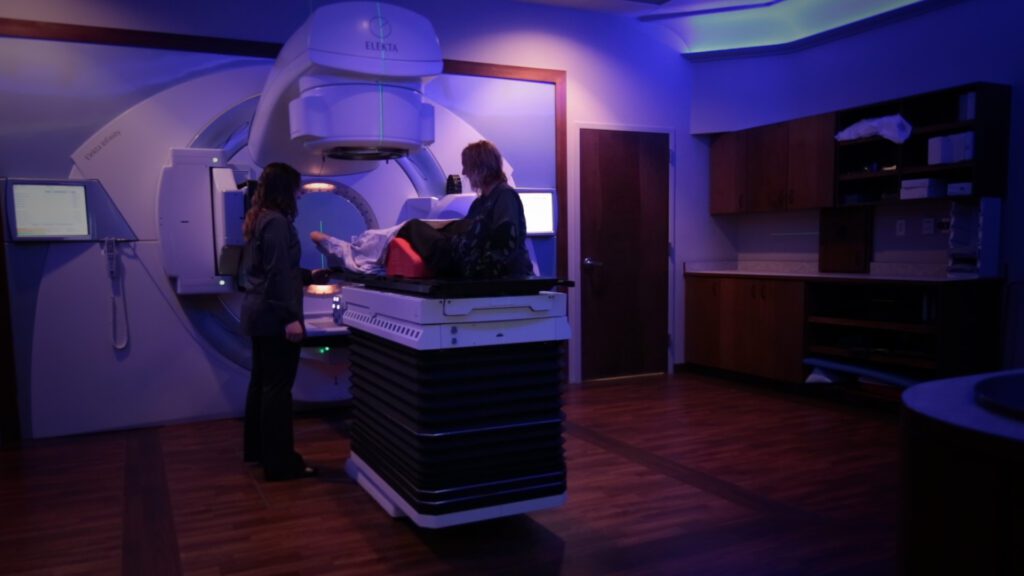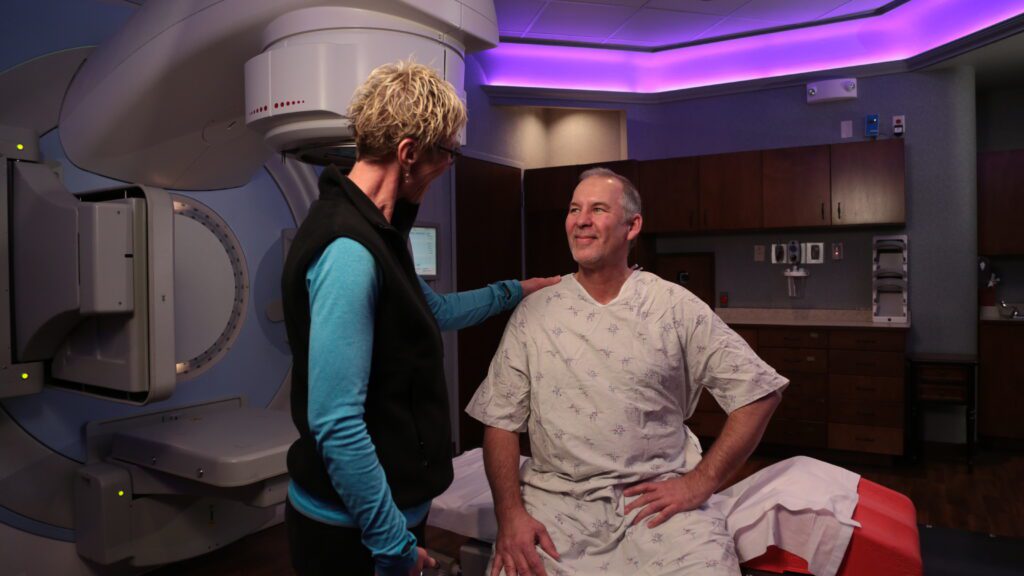

3-D and 4-D Image Guided Radiation Therapy (IGRT)
IGRT provides more precise delivery of radiation therapy to the tumor. It “shows” the radiation therapy team exactly where the tumor is located at each treatment, allowing for the patient to be adjusted so the radiation beams accommodate the slightest movement of the organs and tissues during breathing.
External Beam Radiation Therapy (EBRT)
External Beam Radiation Therapy involved directing a beam of radiation from outside the body to a specific cancerous organ or tissue inside the body. Radiation therapy uses a linear accelerator, a high energy x-ray machine, to direct the radiation to the tumor. BCC utilizes Eleka Linear Accelerators.
Intensity Modulated Radiation Therapy (IMRT)
IMRT allows us to increase the dose of radiation to the targeted area and/or reduce the dose to nearby sensitive structures. IMRT uses multiple small radiation beams directed at the tumor from different directions, each one treating with varying intensity, with most of the dose concentrated in the tumor area.
High Dose-Rate Brachytherapy (HDR)
High dose-rate (HDR) brachytherapy involves placing the radiation source within the body, as close to the tumor cells as possible. The radioactive material, the size of the tip of a pen, is sealed in a tube, and placed near the affected tissue. The radiation is concentrated on the cancer cells, lessoning radiation damage to normal tissue near the tumor. HDR can be used to treat the following types of cancers: breast, uterine, cervix, lung and prostate.
Volumetric Modulated Arc Therapy (VMAT)
VMAT establishes new standards for radiation therapy treatment speed and dose reduction for the patient. With Elekta VMAT, single or multiple radiation beams sweep in uninterrupted arcs around the patient, dramatically speeding treatment delivery. Clinicians can use Elekta VMAT with complete or partial arc(s) to reduce treatment delivery times from 8-12 minutes required for conventional radiation therapy to as few as two minutes.
Stereotactic Body Radiation Therapy (SBRT)
SBRT is a way of delivering a high radiation dose to a tumor in the lung, liver or other spot that may not respond well to surgery, chemotherapy, conventional radiation or other treatments. By using special positioning on the treatment machine, we can deliver a higher dose of radiation to a cancer than traditional radiation therapy, while sparing a great deal of healthy tissue and organs. SBRT uses a very specific body mold to place the patients in an exact position for each treatment. These molds are made individually for each patient at the Bismarck Cancer Center.
Stereotactic Radiosurgery (SRS)
Stereotactic Radiosurgery is a highly precise form of radiation therapy used primarily to treat tumors and other abnormalities of the brain. Despite its’ name, SRS is a non-surgical procedure that uses a high dose of radiation to treat certain types of tumors. SRS does not actually remove the tumor but distorts the DNA of tumor cells. As a result, these cells lose their ability to reproduce.
Surface Guided Radiation Therapy (SGRT)
BCC utilizes Vision RT for SGRT. Vision RT is a system that tracks a patient’s position before, and during radiation therapy, to aid in setup and treatment accuracy. This technology can signal for treatment delivery to pause radiation if the patient moves out of the desired treatment position. In addition, BCC also used Deep Inspiration Breath hold (DIBH), for breast cancer treatments to move the heart away from the breast during treatment. DIBH will allow for reduced radiation dose to the cancer patient’s heart.
Volumetric Modulated Arc Therapy (VMAT)
VMAT, Elekta’s advanced arc therapy technique, is another option to existing advanced radiation therapy techniques. With VMAT, single or multiple radiation beams sweep in uninterrupted arcs around the patient, dramatically speeding treatment delivery. Physicians can view the tumor using an imaging technology that is integrated into the treatment system to increase the precision of the treatment. VMAT can reduce exposure to surrounding healthy tissues and reduce treatment time.
Hydrogel
Hydrogel is an option for men who undergo radiation treatment for prostate cancer. It acts as a spacer between the rectum and the prostate, making it much less likely that the rectum is exposed to radiation. Kydrogel is minimally invasive; it is injected into place prior to the start of radiation treatment. Patients may be awake for the procedure. It remains stable during radiation therapy and then is gradually absorbed by the body after radiation has been completed.
HDR Skin Brachytherapy
HDR Skin Brachytherapy is an alternative treatment for selected skin cancer patients, offering precise targeting and minimal side effects. Unlike surgery, this approach avoids damage to surrounding tissues and organs, making it suitable for highly visible areas. With minimal complications and scarring risk, this outpatient treatment provides several benefits:
- Precise targeting: HDR Skin Brachytherapy delivers a concentrated dose of radiation directly to the tumor, sparing nearby healthy tissue.
- Reduced treatment time: Compared to traditional radiation therapy, HDR Skin Brachytherapy involves shorter sessions, typically completed within minutes to hours.
- Enhanced effectiveness: This treatment approach effectively destroys cancer cells, particularly for superficial skin cancers like basal and squamous cell carcinoma.
- Minimized side effects: By minimizing damage to healthy tissues, HDR Skin Brachytherapy reduces the risk of side effects. Common side effects, such as skin redness and irritation, are temporary and resolve over time.
- Convenience and outpatient treatment: HDR Skin Brachytherapy is often performed on an outpatient basis, allowing patients to return home on the same day and minimizing disruption to their daily routines.
HDR Prostate Brachytherapy
HDR Prostate Brachytherapy directly places a source of radiation inside a patient’s prostate while the patient is sedated. This allows a higher radiation dose to the prostate area without affecting the tissue around it, providing a very precise treatment dose given over a shorter amount of time with minimal side effects. There are 2 steps for HDR treatment:
- There will be a procedure to place the needles into the prostate. This will be done under anesthesia.
- HDR treatment(s), which are also called fractions.
- Patients receive 1 or 2 treatments. The radiation oncologist will discuss this with each individual.
- The treatment is done right after the needle placement procedure.
- After treatment, the needles are immediately removed.
- Individuals go home the same day as the treatment.
